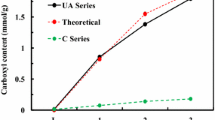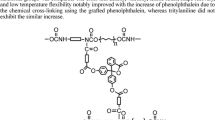Abstract
The synthesis of isocyanate-terminated polyurethane prepolymers was carried out by reacting toluene diisocyanate (TDI) with an acrylic polyol, PEG-400, and PEG-1000, followed by capping the prepolymers with 2-hydroxyethyl methacrylate (HEMA) to produce polyurethane acrylates. The purpose of this study was to examine how different molecular masses of PEG and HEMA impact the thermal, morphological, and hydrophilic/hydrophobic properties of PUA films. The properties of the polyurethane acrylates were analyzed using various techniques, including DSC, FTIR, TGA, 1H NMR, SEM methods, and water contact angles and gloss tests. The results indicated that microphase separation morphology is prevalent within the PUA containing PEG-1000 and that the hydrophilicity of the PUA film is primarily influenced by the microphase separation behavior. The results revealed that the addition of PEG-400 improved the compatibility of hard and soft segments, leading to a shift toward phase mixing in the microphase separation behavior of PU acrylates. The microphase separation behavior was further studied using FTIR analysis of the C = O stretching vibration, with deconvolution performed using Origin software. The findings provide valuable insights into the structure–property relationships of PU acrylates, which can be utilized to optimize their performance for different applications.








Similar content being viewed by others
References
Rao Z, Yan H, Tao W, Liu C, Jian G, Zhou Y, Chen H, Yang M. Effects of aminopropyl-terminated polydimethylsiloxane on structure and properties of waterborne polyurethane-acrylate. Prog Org Coat. 2023;174:107314. https://doi.org/10.1016/j.porgcoat.2022.107314.
Choi J-S, Seo J, Khan SB, Jang ES, Han H. Effect of acrylic acid on the physical properties of UV-cured poly(urethane acrylate-co-acrylic acid) films for metal coating. Prog Org Coat. 2011;71:110–6. https://doi.org/10.1016/j.porgcoat.2011.01.005.
Dong F, Qian Y, Xu X, Shaghaleh H, Guo L, Liu H, Wang S. Preparation and characterization of UV-curable waterborne polyurethane using isobornyl acrylate modified via copolymerization. Polym Degrad Stab. 2021;184:109474. https://doi.org/10.1016/j.polymdegradstab.2020.109474.
Khasraghia SS, Shojaeia A, Sundararaj U. Bio-based UV curable polyurethane acrylate: morphology and shape memory behaviors. Eur Polym J. 2019;118:514–27. https://doi.org/10.1016/j.eurpolymj.2019.06.019.
Choia J-S, Seob J, Khanc SB, Janga ES, Han H. Effect of acrylic acid on the physical properties of UV-cured poly(urethane acrylate-co-acrylic acid) films for metal coating. Prog Org Coat. 2011;71:110–6. https://doi.org/10.1016/j.porgcoat.2011.01.005.
Sanai Y, Ninomiya T, Arimitsu K. Improvements in the physical properties of UV-curable coating by utilizing type II photoinitiator. Prog Org Coat. 2021;151:106038. https://doi.org/10.1016/j.porgcoat.2020.106038.
Wang X, Soucek MD. Investigation of non-isocyanate urethane dimethacrylate reactive diluents for UV-curable polyurethane coatings. Prog Org Coat. 2013;76:1057–67. https://doi.org/10.1016/j.porgcoat.2013.03.001.
Fu J, Yu H, Wang L, Fahad S. Preparation and properties of UV-curable diamine-based polyurethane acrylate hard coatings. Appl Surf Sci. 2020;533:147442. https://doi.org/10.1016/j.apsusc.2020.147442.
Xu H, Qiu F, Wang Y, Wu W, Yang D, Guo Q. UV-curable waterborne polyurethane-acrylate: preparation, characterization and properties. Prog Org Coat. 2012;73:47–53. https://doi.org/10.1016/j.porgcoat.2011.08.019.
Peruzzoa PJ, Anbindera PS, Pardinia OR, Vegac J, Costad CA, Galembeckd F, Amalvy JI. Waterborne polyurethane/acrylate: Comparison of hybrid and blend systems. Prog Org Coat. 2011;72:429–37. https://doi.org/10.1016/j.porgcoat.2011.05.016.
Fu J, Yu H, Wang L, Lin L, Khan RU. Preparation and properties of UV-curable hyperbranched polyurethane acrylate hard coatings. Prog Org Coat. 2020;144:105635. https://doi.org/10.1016/j.porgcoat.2020.105635.
Keramatinia M, Najafi F, Saeb MR. Synthesis and viscoelastic properties of acrylated hyperbranched polyamidoamine UV-curable coatings with variable microstructures. Prog Org Coat. 2017;113:151–9. https://doi.org/10.1016/j.porgcoat.2017.09.005.
Kunwong D, Sumanochitraporn N, Kaewpirom S. Curing behavior of a UV-curable coating based on urethane acrylate oligomer: the influence of reactive monomers, Songklanakarin. J Sci Technol. 2011;33:201–7.
Yildiz Z, Onen HA, Gungor A, Wang Y, Jacob K. Effects of NCO/OH ratio and reactive diluent type on the adhesion strength of polyurethane methacrylates for cord/rubber composites. Polym Plast Technol Eng. 2018;57:935–44. https://doi.org/10.1080/03602559.2017.1364382.
Gite VV, Mahulikar PP, Hundiwale DG. Preparation and properties of polyurethane coatings based on acrylic polyols and trimer of isophorone diisocyanate. Prog Org Coat. 2010;68:307–12. https://doi.org/10.1016/j.porgcoat.2010.03.008.
Cheng B-X, Gao W-C, Ren X-M, Ouyang X-Y, Zhao Y, Zhao H, Wu W, Huang C-X, Liu Y, Liu X-Y, Li H-N, Li RKY. A review of microphase separation of polyurethane: Characterization and applications. Polym Test. 2022;107:107489. https://doi.org/10.1016/j.polymertesting.2022.107489.
Fakhar A, Sadeghi M, Dinari M, Lammertink R. Association of hard segments in gas separation through polyurethane membranes with aromatic bulky chain extenders. J Membr Sci. 2019;574:136–46. https://doi.org/10.1016/j.memsci.2018.12.062.
Choperena A, Painter P. Hydrogen bonding in polymers: effect of temperature on the OH stretching bands of poly(vinylphenol). Macromolecules. 2009;42:6159–65. https://doi.org/10.1021/ma900928z.
Sultan M, Atta S, Bhatti HN, Islam A, Jamil T, Bibi I, Gull N. Synthesis, characterization, and application studies of polyurethane acrylate thermoset coatings: effect of hard segment. Polym Plast Technol Eng. 2017;56:1608–18. https://doi.org/10.1080/03602559.2017.1280736.
Zubera M, Shaha SAA, Jamil T, Asghar MI. Performance behavior of modified cellulosic fabrics using polyurethane acrylate copolymer. Int J Biol Macromol. 2014;67:254–9. https://doi.org/10.1016/j.ijbiomac.2014.03.021.
Huang H, Pang H, Huang J, Yu P, Li J, Lu M, Liao B. Influence of hard segment content and soft segment length on the microphase structure and mechanical performance of polyurethane-based polymer concrete. Constr Build Mater. 2021;284:122388. https://doi.org/10.1016/j.conbuildmat.2021.122388.
Paraskar PM, Hatkar VM, Kulkarni RD. Facile synthesis and characterization of renewable dimer acid-based urethane acrylate oligomer and its utilization in UV-curable coatings. Prog Org Coat. 2020;149:105946. https://doi.org/10.1016/j.porgcoat.2020.105946.
Molavi H, Shojaei A, Mousavi SA. Photo-curable acrylate polyurethane as efficient composite membrane for CO2 separation. Polymer. 2018;149:178–91.
Xiang H, Wang X, Xi L, Dong H, Hong P, Su J, Cui Y, Liu X. Effect of soft chain length and generation number on properties of flexible hyperbranched polyurethane acrylate and its UV-cured film. Prog Org Coat. 2018;114:216–22. https://doi.org/10.1016/j.porgcoat.2017.10.019.
Wang T-L, Hsieh T-H. Effect of polyol structure and molecular weight on the thermal stability of segmented poly(urethaneureas). Polym Degrad Stab. 1997;55:95–102. https://doi.org/10.1016/S0141-3910(96)00130-9.
Fakhar A, Sadeghi M, Dinari M, Mo. Zarabadipoor, R. Lammertink,. Elucidating the effect of chain extenders substituted by aliphatic side chains on morphology and gas separation of polyurethanes. Eur Polym J. 2020;122:109346. https://doi.org/10.1016/j.eurpolymj.2019.109346.
Xie T, Kao W, Zhang Z, Liu Y, Li Z. Synthesis and characterization of organosilicon modified self-matting acrylate polymer: ınsight into surface roughness and microphase separation behavior. Prog Org Coat. 2021;157:106300. https://doi.org/10.1016/j.porgcoat.2021.106300.
Khasraghia SS, Shojaei A, Sundararaj U. Bio-based UV curable polyurethane acrylate: morphology and shape memory behaviors Eur. Polym J. 2019;118:514–27. https://doi.org/10.1016/j.eurpolymj.2019.06.019.
Bari SS, Mishra S. Effect of calcium sulphate nanorods on mechanical properties of chitosan-hydroxyethyl methacrylate (HEMA) copolymer nanocomposites. Carbohydr Polym. 2017;157:409–18. https://doi.org/10.1016/j.carbpol.2016.09.083.
Lin YH, Liao KH, Chou NK, Wang SS, Chu SH, Hsieh KH. UV-curable low-surface-energy fluorinated poly(urethane-acrylate)s for biomedical applications. Eur Polym J. 2008;44:2927–37. https://doi.org/10.1016/j.eurpolymj.2008.06.030.
Acknowledgements
This study was supported by Bilecik Şeyh Edebali University with the project number 2018-01.BŞEÜ.04-07. The authors also thank DYO Paint Factories, Izmir, for the polymers' DSC analysis, contact angle, and gloss measurements.
Author information
Authors and Affiliations
Contributions
BE is responsible for processing the experimental data, conducting the analysis, and creating the figures. EDK is responsible for performing the experiments. BE is responsible for performing the polymer characterization. EE is responsible for writing the draft of the manuscript.
Corresponding author
Additional information
Publisher's Note
Springer Nature remains neutral with regard to jurisdictional claims in published maps and institutional affiliations.
Supplementary Information
Below is the link to the electronic supplementary material.
Rights and permissions
Springer Nature or its licensor (e.g. a society or other partner) holds exclusive rights to this article under a publishing agreement with the author(s) or other rightsholder(s); author self-archiving of the accepted manuscript version of this article is solely governed by the terms of such publishing agreement and applicable law.
About this article
Cite this article
Eren, B., Demir Karaçoban, E., Erdoğan, B. et al. Effect of PEG molecular mass and HEMA capping on the thermal, morphological, and hydrophilic properties of ısocyanate-terminated polyurethane acrylate films. J Therm Anal Calorim 148, 11683–11694 (2023). https://doi.org/10.1007/s10973-023-12507-4
Received:
Accepted:
Published:
Issue Date:
DOI: https://doi.org/10.1007/s10973-023-12507-4




